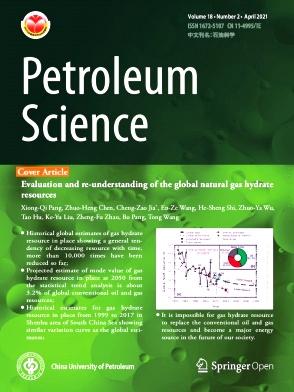CO2-EOR microscopic mechanism under injection–production coupling technology in low-permeability reservoirs
IF 6
1区 工程技术
Q2 ENERGY & FUELS
引用次数: 0
Abstract
Injection–production coupling (IPC) technology holds substantial potential for boosting oil recovery and enhancing economic efficiency. Despite this potential, discussion on gas injection coupling, especially in relation to microscopic mechanisms, remains relatively sparse. This study utilizes microscopic visualization experiments to investigate the mechanisms of residual oil mobilization under various IPC scenarios, complemented by mechanical analysis at different stages. The research quantitatively assesses the degree of microscopic oil recovery and the distribution of residual oil across different injection–production methods. Findings reveal that during the initial phase of continuous gas injection (CGI), the process closely mimics miscible displacement, gradually transitioning to immiscible displacement as CO2 extraction progresses. Compared to CGI, the asynchronous injection–production (AIP) method improved the microscopic oil recovery rate by 6.58%. This enhancement is mainly attributed to significant variations in the pressure field in the AIP method, which facilitate the mobilization of columnar and porous residual oil. Furthermore, the synchronous cycle injection (SCI) method increased microscopic oil recovery by 13.77% and 7.19% compared to CGI and AIP, respectively. In the SCI method, membrane oil displays filamentary and Kármán vortex street flow patterns. The dissolved and expanded crude oil tends to accumulate and grow at the oil–solid interface due to adhesive forces, thereby reducing migration resistance. The study findings provide a theoretical foundation for improving oil recovery in low-permeability reservoirs.
低渗透油藏注采耦合技术下CO2-EOR微观机理研究
注采耦合(IPC)技术在提高原油采收率和经济效益方面具有巨大的潜力。尽管有这种潜力,但关于注气耦合的讨论,特别是与微观机制有关的讨论仍然相对较少。本研究利用显微可视化实验研究了不同IPC情景下剩余油的动员机理,并辅以不同阶段的力学分析。定量评价了不同注采方式的微观采油程度和剩余油分布。研究结果表明,在连续注气(CGI)的初始阶段,该过程与混相驱替非常相似,随着CO2萃取的进行,该过程逐渐过渡到非混相驱替。与CGI相比,异步注采(AIP)方法的微观采收率提高了6.58%。这种增强主要归因于AIP方法中压力场的显著变化,这有利于柱状和多孔剩余油的动员。与CGI和AIP相比,同步循环注入(SCI)方法的微观采收率分别提高了13.77%和7.19%。在SCI方法中,膜油表现为丝状和Kármán涡旋街流模式。溶解膨胀后的原油由于黏附力的作用,容易在油固界面处聚集生长,从而降低了运移阻力。研究结果为提高低渗透油藏采收率提供了理论依据。
本文章由计算机程序翻译,如有差异,请以英文原文为准。
求助全文
约1分钟内获得全文
求助全文
来源期刊

Petroleum Science
地学-地球化学与地球物理
CiteScore
7.70
自引率
16.10%
发文量
311
审稿时长
63 days
期刊介绍:
Petroleum Science is the only English journal in China on petroleum science and technology that is intended for professionals engaged in petroleum science research and technical applications all over the world, as well as the managerial personnel of oil companies. It covers petroleum geology, petroleum geophysics, petroleum engineering, petrochemistry & chemical engineering, petroleum mechanics, and economic management. It aims to introduce the latest results in oil industry research in China, promote cooperation in petroleum science research between China and the rest of the world, and build a bridge for scientific communication between China and the world.
 求助内容:
求助内容: 应助结果提醒方式:
应助结果提醒方式:


